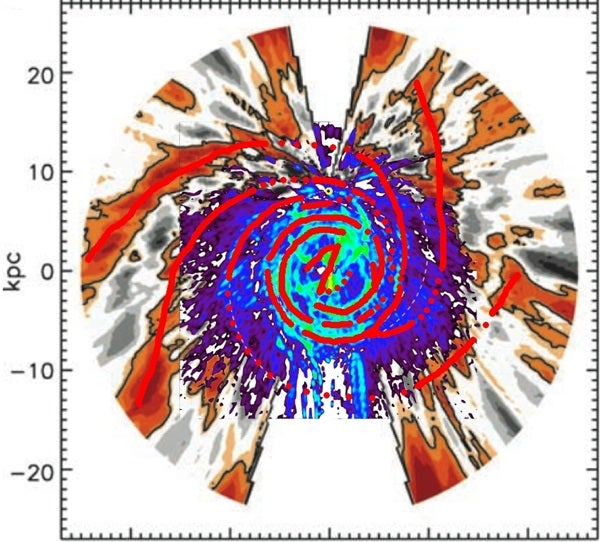A research team has developed the first complete map of the Milky Way galaxy’s spiral arms. The map shows the inner part of the Milky Way has two prominent, symmetric spiral arms that extend into the outer galaxy where they branch into four spiral arms.
“For the first time these arms are mapped over the entire Milky Way,” said Martin Pohl, an Iowa State associate professor of physics and astronomy. “The branching of two of the arms may explain why previous studies – using mainly the inner or mainly the outer galaxy – have found conflicting numbers of spiral arms.”
Pohl, Peter Englmaier of the University of Zurich in Switzerland, and Nicolai Bissantz of Ruhr-University in Bochum, Germany, developed the new map.
As the Sun and other stars revolve around the center of the Milky Way, researchers cannot see the spiral arms directly, but have to rely on indirect evidence to find them. In the visible light, the Milky Way appears as an irregular, densely populated strip of stars. Dark clouds of dust obscure the galaxy’s central region, so it cannot be observed in visible light.
The NASA’s Cosmic Background Explorer satellite mapped the Milky Way in infrared light using an instrument called the Diffuse IR Background Experiment. The infrared light makes the dust clouds almost fully transparent.
Englmaier and Bissantz used the infrared data from the satellite to develop a kinematic model of gas flow in the inner galaxy. Pohl used the model to reconstruct the distribution of molecular gas in the galaxy. And that led to the researchers’ map of the galaxy’s spiral arms.
Studies of the Milky Way Galaxy are an important reference point for the interpretation of other galaxies.
Astrophysicists know that the stars in the Milky Way are distributed as a disk with a central bulge dominated by a long bar-shaped arrangement of stars. Outside this central area, stars are located along spiral arms.
In addition to the two main spiral arms in the inner galaxy, two weaker arms exist. These arms end about 10,000 light-years from the galaxy’s center. The Sun is located about 25,000 light-years from the galactic center. One of these arms has been known for a long time but has always been a mystery because of its large deviation from circular motion. The new model explains the deviation as a result of alternations to its orbit caused by the bar’s gravitational pull. The other symmetric arm on the farside of the galaxy was recently found in gas data.
The discovery of this second arm was a great relief for Englmaier: “Finally it is clear that our model assumption of symmetry was correct and the inner galaxy is indeed quite symmetric in structure.”
Other scientific groups are already interested in using the new map for their research. A group from France, for example, hopes to use it in their search for dark matter.










